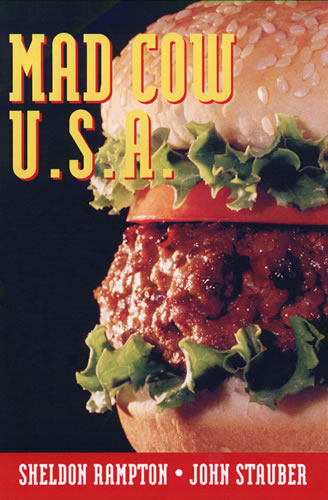Mad Cow USA
 by Sheldon Rampton and John Stauber
by Sheldon Rampton and John Stauber
Now in Paperback with a new foreword by the authors
Publisher: Common Courage Press, Monroe, Maine
ISBN 1-56751-110-4
Bookstore price: $17.95 U.S.
Ask for it in your local bookstore or order it directly. To order by mail, send $20/book (includes postage & handling) to: CMD, 520 University Avenue, Suite 260, Madison, WI 53703.
- Description
- Reviews
- Contents
- About the Authors
- Order Online
- Read the Latest Updates on Mad Cow Disease
Before there was Fast Food Nation, there was Mad Cow USA. Those who read this book when it first appeared in 1997 were shocked but not surprised on December 23, 2003, when the U.S. Secretary of Agriculture announced that mad cow disease had been found in America. Six years earlier, Stauber and Rampton warned in Mad Cow USA that government and industry in the US had failed to take the necessary steps to prevent this bizarre and deadly dementia disease from spreading through contaminated feed into livestock and humans. The feeding of rendered slaughterhouse waste to livestock, which spreads mad cow disease and created an epidemic in England, continues to be both legal and widespread in the United States. Dairy calves are literally weaned on cattle blood protein in calf milk formula, while government and industry feed the American public a dangerous diet of outright lies, false assurances and deceptive PR.
"Rampton and Stauber are two of America's bravest, finest journalists."
--Eric Schlosser,
author of Fast Food Nation
WHAT REVIEWERS ARE SAYING
"Most accessible and informative... a lively account... The language is clear and straightforward... Sheldon Rampton and John Stauber tell this larger tale with style, aided by accounts of some richly colourful characters... Their exhaustive exploration of the people, the ideas and the growing understanding of TSEs is thought-provoking... dancing prose."
--New Scientist, April 4, 1998
"Will be received with interest by a large number of readers of different backgrounds and perspectives."
--Journal of the American Medical Association, June 24, 1998
"The kind of book you can't put down. It tells with great clarity a complicated story that interweaves intrigue, horror, massive economic interests, cannibalism, death, and some rather curious science... [The authors] have done the legwork and research necessary to produce a solid accounting of the affliction of mad cow disease, the mess that was made of handling it in Britain, and its implications for the US... required reading."
--Chemical & Engineering News, April 20, 1998
"In a first-rate piece of investigative journalism, Rampton and Stauber piece together the best synthesis of the problem I've seen. Mad Cow USA is an important book. And it reads like a detective story."
--Timothy B. McCall, M.D., author of Examining Your Doctor: A Patient's Guide to Avoiding
Harmful Medical Care
"It's not just cows that are mad--so are our so-called 'consumer protectors.' You'll be mad as hell too after reading this dynamite book."
--Jim Hightower, radio talk show host and author of There's Nothing in the Middle of the Road but Yellow Stripes and Dead Armadillos
"Gripping... important... highly recommended."
--Library Journal
"No one who has read Mad Cow USA was the least bit surprised by the discovery of an American cow with BSE."
--Michael Pollan, author of Botany of Desire
TABLE OF CONTENTS
Acknowledgments
Foreword
SECTION ONE: The Burden of Proof
- The Girl Who Wouldn't Go Away
- Food Fight
SECTION TWO: The Thing That Eats Your Brain
- First Tremors
- Kuru
- The Virus That Wasn't There
SECTION THREE: The Interests of Industry
- Cannibal Meat
- Acceptable Risks
SECTION FOUR: Danger Signs
- Outbreak in America's Dairyland
- Mad Cows and Englishmen
SECTION FIVE: Crisis Containment
- Scrapie, American-Style
- Bent Proteins
- Worst-Case Scenario
- One Bad Apple
- We See Nothing
- Counting Sheep
SECTION SIX: Meltdown
- Apocalypse Cow
- Who Will Tell the People?
- Feeding Frenzy
SECTION SEVEN: Reckoning
- Truth and Consequences
- Could the Nightmare Happen Here?
Glossary of Terms
Notes
Index
- 66404 reads
 Printer-friendly version
Printer-friendly version- Add new comment





Comments
This book is just a bunch of
This book is just a bunch of bullshit fear-mongering from two disengenous propagandists.
The prion that causes Mad Cow
The prion that causes Mad Cow has ALREADY been found in the US...so, your comments are ridiculous
BS fear-mongering?
Except that, back when they were originally claiming it couldn't happen here, Stauber predicted it would, and then the claim would be "okay, it happened here, but we caught it and there's no danger....."
When "BS fear-mongering" actually comes true, they you need to re-evaluate why you labeled it so.
When you call it that AFTER it's been proven true, then you're just a jackass.
Hiii
It takes years, if not decades, from the time someone is exposed to the disease until the first signs appear. After the first signs appear, the brain can deteriorate within a year Mad Cow Disease
Rapid deterioration?
My mother presented symptoms 5 years prior to her death from sCJD in 2013. Please read the very recent story of Ritchii Kara, 28, of Rye Close, Saltdean, he has been experiencing symtoms of vCJD for the last 4 years. http://m.theargus.co.uk/news/10631032.Doctors_tell_28_year_old_Saltdean_vegetarian_he_has_just_months_to_live_after_contracting_CJD/ What the history of CJD tell us is that there is no rule, it varies a lot. There has been one case that the person died 16 years after being diagnosed...One of the individuals infected by blood transfusion, died 5 years after infection...
objective
Cody, Science is not perfect but is the best option available to explain and understand the world around us. Regarding spongiform encephalopathy, I agree science has a long way to go. I am not all knowing so I do rely on those who are educated in the field to provide valid information as it pertains to their field. The validity of this information is maintained by industry standards as well as peer review within scientific communities. Having a dissmissive attitude or making unsubstantiated discounts of information shows lack of objectivity thus destroying a individuals credibility. Those attempting to aid knowledge and understanding are not propagandist. This title is saved for those trying to prevent it.
MAD COW USDA $$$
How the California cow got the disease remains unknown. Government officials expressed confidence that contaminated food was not the source, saying the animal had atypical L-type BSE, a rare variant not generally associated with an animal consuming infected feed. However, a BSE expert said that consumption of infected material is the only known way that cattle get the disease under natural conditons. “In view of what we know about BSE after almost 20 years experience, contaminated feed has been the source of the epidemic,” said Paul Brown, a scientist retired from the National Institute of Neurological Diseases and Stroke. BSE is not caused by a microbe. It is caused by the misfolding of the so-called “prion protein” that is a normal constituent of brain and other tissues. If a diseased version of the protein enters the brain somehow, it can slowly cause all the normal versions to become misfolded. It is possible the disease could arise spontaneously, though such an event has never been recorded, Brown said.
http://www.washingtonpost.com/national/health-science/case-of-mad-cow-disease-found-in-california-animal-but-food-supply-said-safe/2012/04/24/gIQAtelqfT_story.html
counterpart: Creutzfeldt-Jakob disease (CJD). In a statement released on 24 April, Karen Ross, Secretary of the California Department of Food and Agriculture said, “The detection of BSE shows that the surveillance program in place in California and around the country is working.” Food safety advocates such as Yonkers, New York, -based Consumers Union say it’s a warning sign that surveillance is inadequate and needs to be stepped up. Ross’s statement also makes a point of noting a key feature of this particular case: The infected cow carried what is known as ‘L-type’ BSE, a version of the disease that has not been detected before in the US and has so far not been associated with transmission through animal feed. As the policy debate over testing rumbles on, here is a short guide to what is known and not known about this rare strain and its unexpected appearance.
http://blogs.nature.com/news/2012/04/california-bse-prion-comes-with-a-different-twist.html
STATEMENT FROM CDFA SECRETARY KAREN ROSS ON USDA ANNOUNCEMENT OF DETECTION OF BSE Release #12-016 Print This Release SACRAMENTO, April 24, 2012 – CDFA Secretary Karen Ross issued this statement following the USDA’s announcement of the detection of atypical bovine spongiform encephalopathy (BSE) in a California dairy cow: “The detection of BSE shows that the surveillance program in place in California and around the country is working. Milk and beef remain safe to consume. The disease is not transmitted through milk. Because of the strength of the food protection system, the cow did not enter the food or feed supply. There are numerous safeguards in place to prevent BSE from entering the food chain. “The atypical BSE designation is important because this is a very rare form of BSE not generally associated with an animal consuming infected feed. CDFA veterinarians are working with the USDA to investigate this case and to identify whether additional cows are at risk. Feed restrictions in place in California and around the country for the last 15 years minimize that risk to the greatest degree possible. We will provide additional information about this case as it becomes available.” The USDA announcement may be viewed at:
http://www.usda.gov/wps/portal/usda/usdahome?contentid=2012/04/0132.xml&contentidonly=true http://www.cdfa.ca.gov/egov/Press_Releases/Press_Release.asp?PRnum=12-016
CDC - Bovine Spongiform Encephalopathy and Variant Creutzfeldt ... Dr. Paul Brown is Senior Research Scientist in the Laboratory of Central Nervous System ... Address for correspondence: Paul Brown, Building 36, Room 4A-05, ...
http://www.cdc.gov/ncidod/eid/vol7no1/brown.htm
CDC DR. PAUL BROWN TSE EXPERT COMMENTS 2006 In an article today for United Press International, science reporter Steve Mitchell writes: Analysis: What that mad cow means By STEVE MITCHELL
UPI Senior Medical Correspondent WASHINGTON, March 15 (UPI) -- The U.S. Department of Agriculture was quick to assure the public earlier this week that the third case of mad cow disease did not pose a risk to them, but what federal officials have not acknowledged is that this latest case indicates the deadly disease has been circulating in U.S. herds for at least a decade. The second case, which was detected last year in a Texas cow and which USDA officials were reluctant to verify, was approximately 12 years old. These two cases (the latest was detected in an Alabama cow) present a picture of the disease having been here for 10 years or so, since it is thought that cows usually contract the disease from contaminated feed they consume as calves. The concern is that humans can contract a fatal, incurable, brain-wasting illness from consuming beef products contaminated with the mad cow pathogen. "The fact the Texas cow showed up fairly clearly implied the existence of other undetected cases," Dr. Paul Brown, former medical director of the National Institutes of Health's Laboratory for Central Nervous System Studies and an expert on mad cow-like diseases, told United Press International. "The question was, 'How many?' and we still can't answer that." Brown, who is preparing a scientific paper based on the latest two mad cow cases to estimate the maximum number of infected cows that occurred in the United States, said he has "absolutely no confidence in USDA tests before one year ago" because of the agency's reluctance to retest the Texas cow that initially tested positive. USDA officials finally retested the cow and confirmed it was infected seven months later, but only at the insistence of the agency's inspector general. "Everything they did on the Texas cow makes everything they did before 2005 suspect," Brown said. Despite this, Brown said the U.S. prevalence of mad cow, formally known as bovine spongiform encephalopathy, or BSE, did not significantly threaten human or cattle health. "Overall, my view is BSE is highly unlikely to pose any important risk either in cattle feed or human feed," he said. However, Jean Halloran of Consumers Union in Yonkers, N.Y., said consumers should be troubled by the USDA's secrecy and its apparent plan to dramatically cut back the number of mad cow tests it conducts. "Consumers should be very concerned about how little we know about the USDA's surveillance program and the failure of the USDA to reveal really important details," Halloran told UPI. "Consumers have to be really concerned if they're going to cut back the program," she added. Last year the USDA tested more than 300,000 animals for the disease, but it has proposed, even in light of a third case, scaling back the program to 40,000 tests annually. "They seem to be, in terms of actions and policies, taking a lot more seriously the concerns of the cattle industry than the concerns of consumers," Halloran said. "It's really hard to know what it takes to get this administration to take action to protect the public." The USDA has insisted that the safeguards of a ban on incorporating cow tissue into cattle feed (which is thought to spread the disease) and removal of the most infectious parts of cows, such as the brain and spinal cord, protect consumers. But the agency glosses over the fact that both of these systems have been revealed to be inadequately implemented. The feed ban, which is enforced by the Food and Drug Administration, has been criticized by the Government Accountability Office in two reports, the most recent coming just last year. The GAO said the FDA's enforcement of the ban continues to have weaknesses that "undermine the nation's firewall against BSE." USDA documents released last year showed more than 1,000 violations of the regulations requiring the removal of brains and spinal cords in at least 35 states, Puerto Rico and the Virgin Islands, with some plants being cited repeatedly for infractions. In addition, a violation of similar regulations that apply to beef exported to Japan is the reason why Japan closed its borders to U.S. beef in January six weeks after reopening them. Other experts also question the adequacy of the USDA's surveillance system. The USDA insists the prevalence of mad cow disease is low, but the agency has provided few details of its surveillance program, making it difficult for outside experts to know if the agency's monitoring plan is sufficient. "It's impossible to judge the adequacy of the surveillance system without having a breakdown of the tested population by age and risk status," Elizabeth Mumford, a veterinarian and BSE expert at Safe Food Solutions in Bern, Switzerland, a company that provides advice on reducing mad cow risk to industry and governments, told UPI. "Everybody would be happier and more confident and in a sense it might be able to go away a little bit for (the USDA) if they would just publish a breakdown on the tests," Mumford added. UPI requested detailed records about animals tested under the USDA's surveillance plan via the Freedom of Information Act in May 2004 but nearly two years later has not received any corresponding documents from the agency, despite a federal law requiring agencies to comply within 30 days. This leaves open the question of whether the USDA is withholding the information, does not have the information or is so haphazardly organized that it cannot locate it. Mumford said the prevalence of the disease in U.S. herds is probably quite low, but there have probably been other cases that have so far gone undetected. "They're only finding a very small fraction of that low prevalence," she said. Mumford expressed surprise at the lack of concern about the deadly disease from American consumers. "I would expect the U.S. public to be more concerned," she said. Markus Moser, a molecular biologist and chief executive officer of Prionics, a Swiss firm that manufactures BSE test kits, told UPI one concern is that if people are infected, the mad cow pathogen could become "humanized" or more easily transmitted from person to person. "Transmission would be much easier, through all kinds of medical procedures" and even through the blood supply, Moser said.
© Copyright 2006 United Press International, Inc. All Rights Reserved
http://www.upi.com/ConsumerHealthDaily/view.php?StoryID=20060315-055557-1284r http://www.upi.com/Science_News/2003/12/30/Mad-Cow-Linked-to-thousands-of-CJD-cases/UPI-47861072816318/
PAUL BROWN COMMENT TO ME ON THIS ISSUE
Tuesday, September 12, 2006 11:10 AM
\
"Actually, Terry, I have been critical of the USDA handling of the mad cow issue for some years, and with Linda Detwiler and others sent lengthy detailed critiques and recommendations to both the USDA and the Canadian Food Agency."
OIE says the animal was sub-clinical ;
http://web.oie.int/wahis/public.php?page=single_report&pop=1&reportid=11893
also, officials have confirmed it was a atypical L-type BASE BSE. I am deeply disturbed about the false and terribly misleading information that is being handed out by the USDA FDA et al about this recent case of the atypical L-type BASE BSE case in California. these officials are terribly misinformed (I was told they are not lying), about the risk factor and transmissibility of the atypical L-type BASE BSE. these are very disturbing transmission studies that the CDC PUT OUT IN 2012. I urge officials to come forward with the rest of this story. It is important to reiterate here, even though this animal did not enter the food chain, the fact that the USA now finds mad cow disease in samplings of 1 in 40,000 is very disturbing, and to add the fact that it was an atypical L-type BASE BSE, well that is very disturbing in itself. 1 out of 40,000, would mean that there were around 25 mad cows in the USA annually going by a National herd of 100 million (which now I don’t think the USA herd is that big), but then you add all these disturbing factors together, the documented link of sporadic CJD cases to atypical L-type BASE BSE, the rise in sporadic CJD cases in the USA of a new strain of CJD called ‘classification pending Creutzfeldt Jakob Disease’ cpCJD, in young and old, with long duration of clinical symptoms until death. the USA has a mad cow problem and have consistently covered it up. it’s called the SSS policy. ...
see full text with updated transmission studies and science on the atypical L-type BASE BSE Jan. 2012 CDC. ...
***Oral Transmission of L-type Bovine Spongiform Encephalopathy in Primate Model
***Infectivity in skeletal muscle of BASE-infected cattle
***feedstuffs- It also suggests a similar cause or source for atypical BSE in these countries.
***Also, a link is suspected between atypical BSE and some apparently sporadic cases of Creutzfeldt-Jakob disease in humans.
now, for the rest of the story, the most updated science on the atypical BSE strains, and transmission studies...
Thursday, April 26, 2012
Update from USDA Regarding a Detection of Bovine Spongiform Encephalopathy (BSE) in the United States WASHINGTON bulletin at 04/26/2012 10:11 PM EDT
http://transmissiblespongiformencephalopathy.blogspot.com/2012/04/update-from-usda-regarding-detection-of.html
kind regards, terry
Terry S. Singeltary Sr. P.O. Box 42 Bacliff, Texas, USA 77518 flounder9@verizon.net